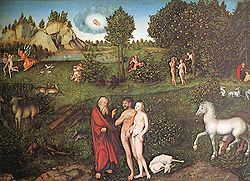History
Early narratives in art
Early narratives in art
Sequential depictions onTrajan's Column
In Lucas Cranach the Elder's "Adam and Eve" different scenes of the Biblical story are shown in the same painting: on the front, God is admonishing the couple for their sin; in the background to the right are shown the earlier scenes of Eve's creation from Adam's rib and of their being tempted to eat the forbidden fruit; on the left is the later scene of their expulsion from Paradise.
Comics as an art form established itself in the late 19th and early 20th century, alongside the similar forms of film and animation. The three forms share certain conventions, most noticeably the mixing of words and pictures, and all three owe parts of their conventions to the technological leaps made through theindustrial revolution. Although the comics form was established and popularized in the pages of newspapers and magazines in the late 1890s, narrative illustration has existed for many centuries.
Rome's Trajan's Column, dedicated in 113 AD, is an early surviving examples of a narrative told through the use of sequential pictures, while Egyptian hieroglyphs, Greek friezes, medieval tapestries such as the Bayeux Tapestry and illustratedmanuscripts also demonstrate the use of sequential images and words combined to convey a narrative. In medieval paintings, many sequential scenes of the same story (usually a Biblical one) are simultaneously shown in the same painting (see illustration on the left).
However, these works lack the ability to travel to the reader; it needed the invention of modern printing techniques to allow the form to capture a wide audience and become a mass medium.







0 comments:
Post a Comment
If U like this post then give me a comments about this post